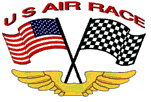
| Home |
| News |
| 2007 Events |
| Entry Kit |
| Info |
| Previous Races |
| Marion Jayne |
| Shop |
| Aviation Links |
| Sponsors |
| Press |
| Scholarships |
| Contact Us |

|
Flying the Race
An insider's look at racing the Marion Jayne Air Race
By Pete Bedell
Race officials layout a specified course either along a runway or series of well-defined landmarks. To negate the effects of wind as much as possible, the course is flown both ways. Several GPS groundspeed readouts are recorded. A check pilot rides with the air race participant to confirm that the throttle is full, the flaps are up, cowl flaps are closed, etc. Often the check pilot is a fellow racer familiar in the type of airplane who will not let you get away with any tricks. After determining the speed in miles per hour, race officials subtract 20 mph. This is strictly to make it look as if everybody is doing well against their handicap. From then on, your handicap is the speed for you to beat. Whoever beats their handicap by the greatest margin wins bragging rights.
Flying starts and finishes. This technique keeps air racing safe for the average pilot. The concept allows a pilot to make a normal takeoff, fly a wide pattern around the airport, and overfly the runway at a safe altitude to begin timing. Flying starts eliminates the need for pilots to race the airplane through the takeoff and departure, which exposes him or her to unnecessary risk. Arriving at the next checkpoint, you are required to fly the designated timing line, then reduce power, and enter a normal landing pattern. Flying starts and finishes keep the pilot in a performance regime with which he or she is familiar during the critical takeoff and landing phases of flight.
Is racing hard on the engine(s)? That was one of our first thoughts when my brothers and I considered entering the 1997 Marion Jayne U.S. Air Race. Our Beech Baron had provided 26 years of faithful service to our family never seeing anything more than 65-percent power for more than the time it took to takeoff and climb to altitude. What would happen to those costly Continentals if we thrashed them around the sky crossing the United States?
As long as the engine is operated within its limits, there should be no problems associated with flying an air race. In the case of newly overhauled engines or those recently top overhauled, the race will be beneficial because of the high cylinder pressures needed to seat new rings. If all engine instruments are in the green, your engine is operating within its certified limits. It's wise to brush up on the operating limitations of your engine(s) prior to the race and be sure that you cross reference these atypical power settings with fuel flow and EGT. Best-power mixture is approximately 100- to 150-degrees rich of peak EGT. Don't be surprised to see that fuel flow at race power settings can be high enough to get a standing ovation from sheiks in the Middle East.
Operate your engine out of its limitations and you're on your own. Bust the rpm redline or lean too aggressively because you underestimated your fuel burn and you'll set the stage for future engine problems or engine failure. Remember that the race is meant to be fun, not fear inducing.
What about the airframe? As with the engine(s), you need to stay within the limitations of the airframe. Racing will force you to be wary of maneuvering speed (VA), never-exceed speed (VNE), and other speeds that may not be much of a factor in day-to-day flying. Control surface flutter is of primary concern during high-speed flight at or near VNE. Busting VNE makes you a test pilot. Elevators, stabilators, and trim tabs are all susceptible to flutter. It's a good idea to have all control surfaces checked for balance prior to the race especially if the airplane was recently painted. Likewise, maneuvering speed or turbulence-penetration airspeed is another critical figure to keep in mind. During low-altitude flights in the middle of the day when bumps are at their worst, remember that you'll likely be operating well above VA. If the bumps are bad enough, climb to a smoother altitude "your overall speed will be better in the smooth air anyway. Consider the descent back into the bumps, however, and plan accordingly.
The most important thing to remember is to enjoy yourself! The Marion Jayne Air Race is a fun gathering of pilots, airplanes, and good times. Playing by the rules yet remaining competitive is the secret to enjoying this unique event. Sit back, enjoy the view, and soak up our country from the unique perch of a general aviation airplane.
Peter A. Bedell was a winning crewmember of the 1997 Marion Jayne U.S. Air Race flying the family Beech D55 Baron with his two brothers. He is an airline pilot and Editor at large for AOPA Pilot magazine.